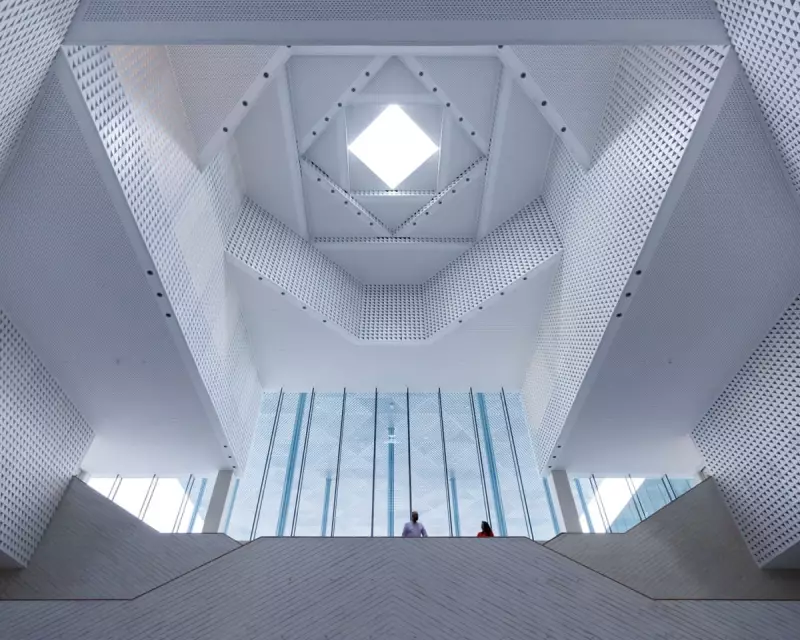
A Monument to Faith and Community Rises in Texas
On a warm autumn day in southern Texas, a remarkable new landmark opens its doors. The Ismaili Centre in Houston, the first of its kind in the United States, stands as a serene sanctuary for the city's 40,000-strong Ismaili Muslim community. Designed by acclaimed architect Farshid Moussavi, this five-storey building took seven years to complete and is engineered to endure for a century or more.
The centre's arrival is marked by the fluttering of monarch butterflies in its gardens, creatures whose epic 3,000-mile migration mirrors the delicate strength and endurance embodied in the architecture itself. More than just a place of worship, the centre will serve as a vibrant hub for cultural exchange and shared activities, reflecting the community's significant presence in one of America's most diverse cities.
An Architectural Tapestry Woven in Stone
Farshid Moussavi, an architect renowned for her refusal to be confined to a single style, has created something entirely unique in Houston. Described as a "tapestry of stone", the building is an elegant ensemble that subtly abstracts the essence of Islamic architecture. Unlike the London Ismaili Centre's more direct appropriation of Islamic motifs, Moussavi's approach is a nuanced distillation focused on spatial experience.
Traces of Persian tradition are evident in the perforated stone screens and the eivans (open-columned verandas), designed to provide shade from Houston's intense heat. These spaces act as social areas and viewing platforms, encouraging movement between the interior and the lush gardens. A unifying triangular geometric motif threads through the entire structure, appearing in screens, light fittings, floors, and furniture, creating what Moussavi calls an "experiential serenity and simplicity."
The stone facade itself is a feat of engineering. It is a non-structural screen made from small square pieces of stone threaded together by steel tension rods. "It's as if you're weaving a carpet on a loom," Moussavi explains, resulting in something light and delicate despite its stone medium. The screen's weave changes with triangular or scallop-shaped cut-outs, which cast incredible, ever-changing shadow patterns within.
A Global Network and a Community's Heart
The Houston centre is the seventh Ismaili Centre to open globally in four decades, joining a network that includes locations from Dushanbe to Vancouver. This reflects the geographic and cultural plurality of the Ismaili diaspora, a Shia Muslim sect originating in the ninth century that now has approximately 12 million adherents in over 70 countries.
The project is deeply rooted in the patronage of the Ismaili Imams. The centre's development was overseen by Prince Karim, Aga Khan IV, a known patron of architecture who established the prestigious Aga Khan Award for Architecture in 1977. He was succeeded earlier this year by his son, Prince Rahim, Aga Khan V.
At the building's core lies the jamatkhana, or prayer hall, a vast, column-free space accommodating 1,500 people. The design philosophy here was to create a room that feels "boundless in spirit." A ceiling of two layers of gauzy aluminium, lit from behind, shimmers and appears to dematerialise. The floor is covered with a patterned ivory carpet, a colour signature to the Persian city of Nain. Instead of a traditional ornate mihrab, the direction of worship is indicated simply by a vertical band of light radiating from an illuminated niche.
A Garden Rooted in Resilience and Heritage
Landscape is integral to the project, serving as both a cultural symbol and a work of resilient environmental engineering to combat Houston's heat and flood risks. Landscape architect Thomas Woltz spent a year studying historic Islamic gardens in Spain, Egypt, and India.
His planting strategy is a "transect of Texas," using exclusively native species to create an evolving ecosystem that begins with desert cacti and moves through prairie to Gulf Coast flora. This design mirrors the adaptability of the Ismaili community in its new homelands. The garden is conceived not as static, but as a living space that will bloom and mature over time, with the migrating monarch butterflies becoming regular visitors.
The project's most resonant aspect may be its profound connection to the local Ismaili community. Many locals assisted in construction or donated materials, and the now-public building will be largely staffed by volunteers.
"It really is a community project in every sense of the word," says Moussavi. "We've provided the community with the hardware – the building itself – and now, I'm sure, the software, the people and activities, will bring it to life." With its serene geometry, luminous spaces, and deeply considered design, the Ismaili Centre, Houston, is not just a building; it is a new home, poised to be animated by the community it was built to serve.





